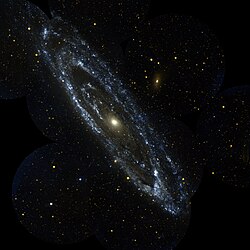Wielka Debata

Wielka Debata (ang. Great Debate) – debata astronomiczna stoczona 26 kwietnia 1920 roku pomiędzy Harlowem Shapleyem a Heberem Curtisem w Muzeum Historii Naturalnej w Waszyngtonie. Treścią debaty były zacięte dyskusje dotyczące natury obserwowanych na niebie mgławic spiralnych oraz rozmiarów Wszechświata. Harlow Shapley był błędnie przekonany, że należą one do naszej ogromnej Galaktyki, gdyż nie istnieją inne galaktyki. Jednocześnie jako pierwszy prawidłowo postulował znacznie większe niż wtedy przypuszczano rozmiary naszej Galaktyki. Heber Curtis twierdził natomiast, że mgławice spiralne są oddzielnymi galaktykami.
Decydujące rozstrzygnięcie przyniosły dane obserwacyjne. W 1923 roku Edwin Hubble, prowadząc obserwacje Galaktyki Andromedy, zaobserwował w niej pojedyncze gwiazdy typu cefeid, które użyte jako świece standardowe pozwoliły na wyznaczenie odległości do tej galaktyki. Odległość ta wielokrotnie przekraczała rozmiary Drogi Mlecznej dowodząc, że mgławice spiralne są w rzeczywistości odległymi galaktykami.
Bibliografia
- The Shapley - Curtis Debate in 1920 (ang.). apod.nasa.gov. [dostęp 2020-04-26].
Media użyte na tej stronie
This image is a Galaxy Evolution Explorer observation of the large galaxy in Andromeda, Messier 31. The Andromeda galaxy, spanning 260,000 light-years across, is the most massive in the local group of galaxies that includes our Milky Way. Andromeda is the nearest large galaxy to our own at approximately 2.5 million light-years away. The image is a mosaic of 10 separate Galaxy Evolution Explorer images taken in September, 2003. This image is a two-color composite, where blue represents far-ultraviolet light and red is near-ultraviolet light, and shows blue regions of young, hot, high mass stars tracing out the spiral arms where star formation is occurring, and the central orange-white "bulge" of old, cooler stars formed long ago. The star forming arms of Messier 31 are unusual in being quite circular rather than the usual spiral shape. Several companion galaxies can also be seen. These include Messier 32, a dwarf elliptical galaxy directly below the central bulge and just outside the spiral arms, and Messier 110 (M110), which is above and to the right of the center. M110 has an unusual far ultraviolet bright core in an otherwise "red," old star halo. Many other regions of star formation can be seen far outside the main body of the galaxy.
